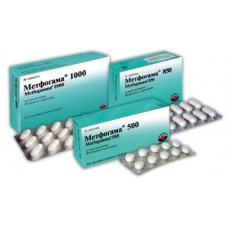Expiration date: 01/2026
The composition and form of issue:
Tablets, film-coated. 1 tablet contains:
Metformin hydrochloride 850 or 1000 mg
other ingredients: hypromellose (15000 CPS) hypromellose (5 CPS) povidone (K-25) magnesium stearate macrogol 6000 titanium dioxide
blistere in 10 PCs. in cardboard pack 3, or 12 blisters.
Description pharmaceutical form:
white, oblong, film-coated, with the fault line.
Pharmacokinetics:
Bioavailability after intake of a standard dose is 50-60%, Cmax in plasma achieved in 2 hours Practically does not bind to plasma proteins and excreted by the kidneys unchanged. T1/2 is 1.5–4.5 h. When violation of the kidney possible accumulation of the drug.
Description pharmacological action:
Inhibits hepatic gluconeogenesis, reduces glucose absorption from the intestines, enhances peripheral glucose utilization, increases tissue sensitivity to insulin. Lowers triglycerides and low-density lipoprotein in the blood. It has a fibrinolytic effect (inhibits the activity of plasminogen activator inhibitor tissue-type) stabilizes or reduces body weight.
Indications:
- Diabetes mellitus type 2 (insulin-independent) without propensity to ketoatsidozu (especially in patients suffering from obesity).
Contraindications:
- hypersensitivity
- diabetic ketoacidosis, diabetic precoma and coma
- pronounced renal dysfunction and liver
- cardiac and respiratory failure
- the acute phase of myocardial infarction
- acute violation of cerebral circulation
- dehydration
- lactic acidosis and references to it in history, that may contribute to the development of lactic acidosis, including chronic alcoholism
- pregnancy
- breast-feeding.
Application of pregnancy and breast-feeding:
Contraindicated in pregnancy. At the time of treatment should stop breastfeeding.
Side effects:
From the cardiovascular system and blood (hematopoiesis, hemostasis): in some cases of megaloblastic anemia.
From the digestive tract: nausea, vomiting, abdominal pain, diarrhea, lack of appetite, a metallic taste in the mouth.
From the metabolic: hypoglycemia, in rare cases, lactic acidosis (requires stopping treatment).
Allergic reactions: skin rash.
Drug interactions:
Sulfonylureas, acarbose, insulin, NSAIDs, inhibitors of MAO, oxytetracycline, ACE inhibitors, derivatives of clofibrate, cyclophosphamide, beta-blockers enhance hypoglycemic action. Weaken the effect of corticosteroids, oral contraceptives, epinephrine and other sympathomimetic agents, thyroid hormones, thiazide and loop diuretics, phenothiazines, nicotinic acid. Cimetidine slows the excretion of Metformin and increases the risk of developing lactic acid acidosis. Metformin reduces the effect of coumarin anticoagulants. The combination with sulfonylureas and insulin (requires careful monitoring of glucose levels in the blood).
Method of application and dose:
Inside, while eating, swallowing whole and squeezed enough liquid (glass of water). The dose is determined individually depending on the level of glucose in the blood.
Initial dose 1 table. Metfogamma 850 per day (corresponding to 850 mg of Metformin hydrochloride), the future may gradually increase the dose depending on effect. Supporting daily dose — table 1-2. Metfogamma 850 (850-1700 mg). The maximum daily dose — 3 table. Metfogamma 850 (2550 mg). In elderly patients the recommended daily dose should not exceed 850 mg. the Daily dose recommended to take in 2 admission (morning and evening). The course of treatment time.
Overdose:
Symptoms: lactic acidosis.
Treatment: cessation of treatment, kidney dialysis, symptomatic therapy.
Precautions:
It continuously monitor kidney function, the level of glucose in the blood. At least 2 times a year, and when myalgia should determine the content of lactate in plasma.
Special instructions:
Not recommended for use in acute infectious diseases or exacerbation of chronic infectious-inflammatory diseases, trauma, acute surgical diseases before the surgery, and for 2 days after meetings, and during the 2 d before and after running the diagnostic tests (radiological and radiological with the use of contrast media). It should not be used in patients follow a diet with caloric restriction (less than 1000 kcal/day). Not recommended the use of the drug in people over 60 years, performing heavy physical work (due to increased risk of developing lactic acid acidosis).
Effects on ability to drive and operate machinery. No effect (when used in monotherapy). In combination with other hypoglycemic agents (sulfonylureas, insulin, etc.) may develop hypoglycemic conditions that impair the ability to drive vehicles and occupation of other potentially hazardous activities, require increased attention and psychomotor speed reactions.





